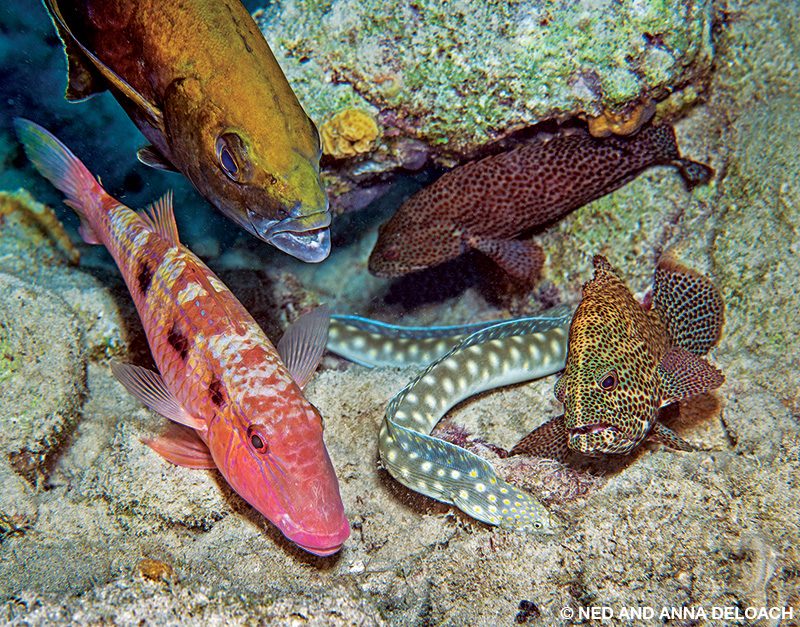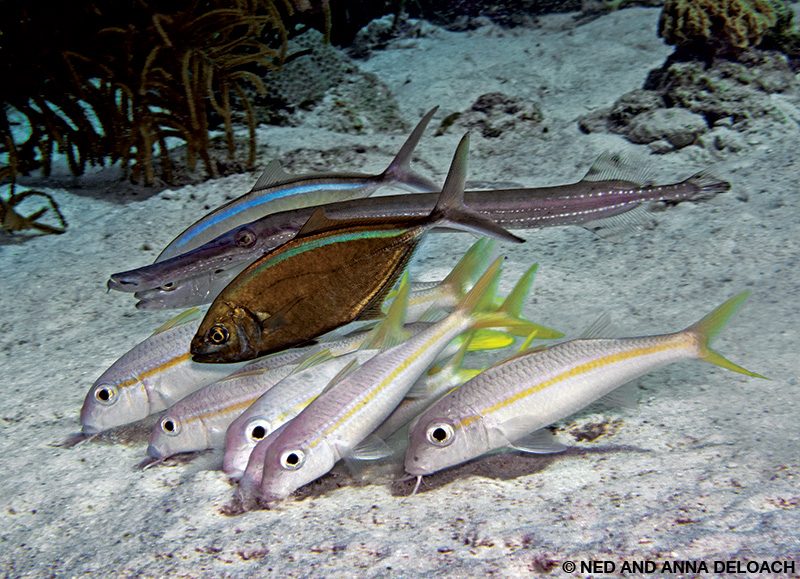For both predators and prey, survival on the reef depends on innovation. As life unfolds, populations of both parties must continually acquire advantages over the other by evolving new and improved physical adaptations that must be countered by the opposition. During the relentless arms race, prey species tend to hold the upper hand — they are just a little too fast, well-camouflaged or spiky to be caught under normal circumstances.
To even the odds, predatory reef fishes game the system by devising novel hunting strategies. Joining forces with third-party species equipped with specialized hunting skills has become the gold standard. Fortunately for divers, these unconventional confederations, which disorient prey by creating abnormal situations, make fascinating fish-watching.
Nuclear hunting, the most common multispecies feeding association, primarily revolves around a foraging eel, octopus or goatfish (the nucleus) followed by a gang of feisty predators looking for an easy meal. The size and scope of these roving packs can be quite impressive. We once counted 13 groupers trailing an octopus in Brazil and an integrated pack made up of seven different species hound-dogging a snake eel across the seafloor in Bonaire.

Even though coral structures appear solid from the outside, their limestone interiors erode with age, leaving behind sanctuaries where little fishes can hide from all major predators except one — eels. With long, flexible bodies and one of the keenest senses of smell in the animal kingdom, morays and snake eels are well-suited for home invasions. When eels are on the prowl, groupers and other opportunistic predators know to fall in behind. The sight of such a formidable mob working its way down the reef sends prey scurrying for cover. When an eel slips into a reef pocket, the small fishes inside panic. Some of them bounce off the walls like pinballs, making easy targets for the eel. Others sprint for the exits and into the waiting mouths of the entourage outside.
Octopuses are every bit as accomplished at causing chaos. In the Caribbean the common octopus makes two one-hour forays each day. Packs of groupers, snappers, jacks and trumpetfish, among others, invariably join the outings. Marvels of boneless engineering, octopuses can disappear into crevices as easily as Jell-O down a drain. Their most valuable assets, however, are eight sucker-lined arms capable of detecting and tickling out tidbits from secret crannies. The tasty shrimp, crunchy crabs and little fishes that somehow make it past the probing arms scramble for daylight, where they meet an equally horrendous fate.
Unlike most wildlife, reef fishes, especially in the heat of a hunt, aren’t particularly bothered by audiences. This bit of luck allows divers the luxury of front-row seats, although at times there is a brief wait before the action begins. The instant an eel pops its head out of the reef, the assembled predators go into their survival-of-the-fittest mode, jockeying to be first on the scene when the eel vanishes into a hideaway. The dominant predators commandeer the best positions with their snouts pressed into openings that lead to the dark chambers where the eel works its mischief.

Attacks come so unexpectedly and with such fury that it’s difficult to distinguish success from failure in the backwash of debris. When we first studied nuclear hunting in the 1990s, it took the better part of a month before we substantiated a capture — and it was by default. The prey was a juvenile filefish. When grabbed by a grouper, it buried its spikelike dorsal spine deep into the roof of the assailant’s mouth. Twenty minutes later, the 10-inch coney had faded into its drab night colors and was listing against a coral head, lying there with its 1-inch victim still lodged in its mouth.
Hiding inside reefs is not the only option for prey. A multitude of invertebrates has taken up life beneath the sand to thwart predators. To counter the convention, goatfishes, one of the reefs’ most common and accomplished carnivores, evolved a pair of tapered appendages known as barbels. The semiridged adaptations, which extend from the lower jaw and are full of taste receptors, can not only pinpoint burrowing worms and crustaceans but also dig up those delicacies. All too often the goatfishes’ meals fall victim to uninvited followings of jacks, trumpetfish and snappers constantly competing to be first at the table.
At popular dive destinations, humans have unwittingly become disturbers extraordinaire. Without question the brazenly bold beachfront tarpons of Bonaire are the most successful and annoying nuclear hunters we’ve encountered. The majestic daytime predators have turned nocturnal and in the process taken nuclear hunting to the next level. It’s not the night divers themselves but rather their beams of light inadvertently spotlighting sleeping prey that keep the great fish up past their bedtime — an abnormal situation and a predator’s dream.
© Alert Diver — Q3/Q4 2020